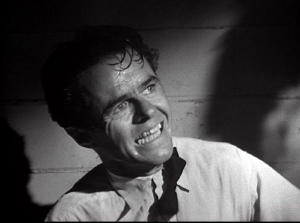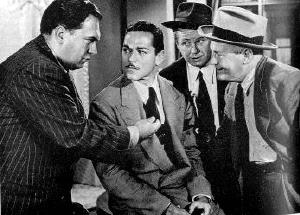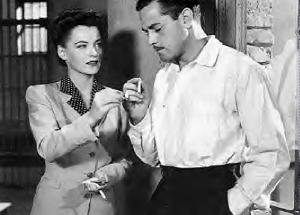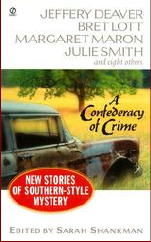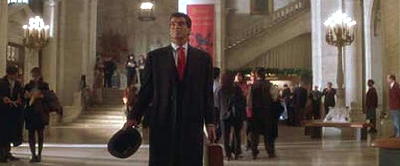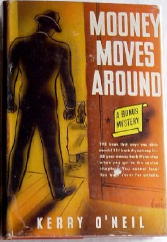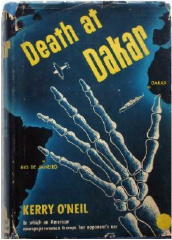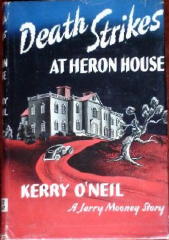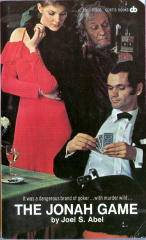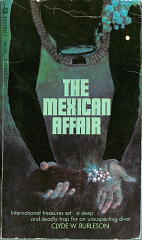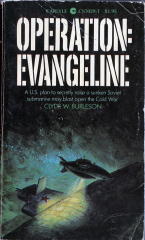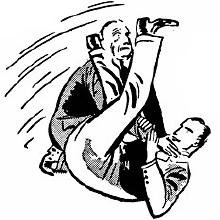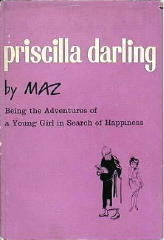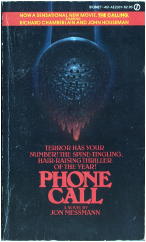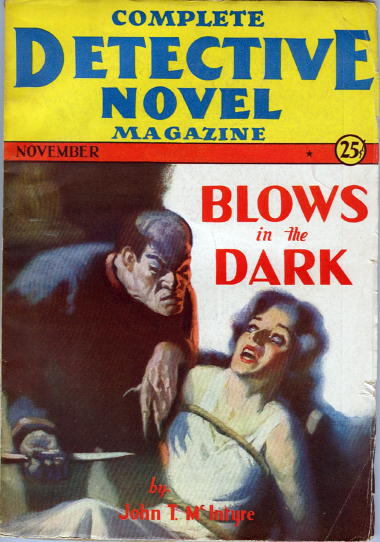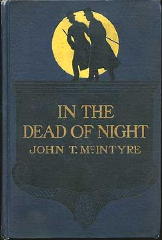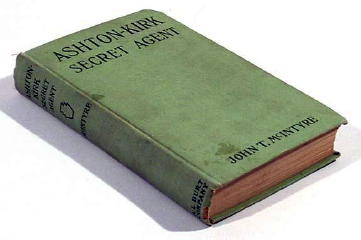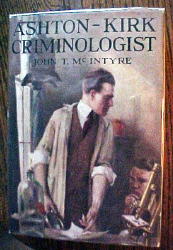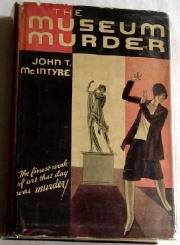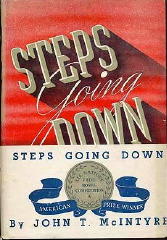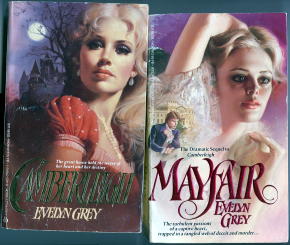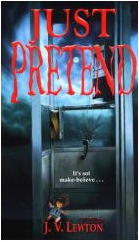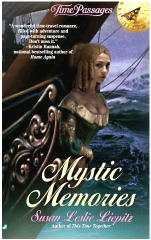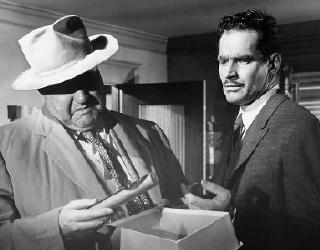April 2008
Monthly Archive
Wed 30 Apr 2008
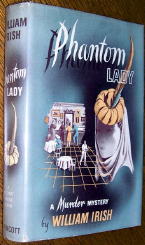
PHANTOM LADY. Universal; 1944. Ella Raines, Franchot Tone, Alan Curtis, Elisha Cook Jr., Thomas Gomez, Fay Helm. Based on the novel by William Irish, aka Cornell Woolrich. Director: Robert Sidomak.
You don’t go to pulp or paperback conventions to see movies, or at least I don’t, but I did this time. The recent Windy City show was great fun – well put on, with lots of people to talk to and hang around with for a few days – and one of the late night attractions was a showing of Phantom Lady, the pulp connection being rather obvious, since Woolrich’s writing career began in the pulp magazines.
First published by Lippincott in 1942, it’s the second novel that Woolrich wrote that I remember reading, the first being Deadline at Dawn (Lippincott, 1944) also as by William Irish, and also made into a movie (RKO, 1946), one that I consider as being my favorite of all time.
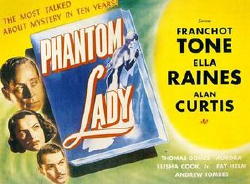
What’s strange, and I haven’t been able to explain it yet, is that I thought I remembered Phantom Lady as a movie, but if I saw it, and I’m sure I did, I didn’t remember it all that well.
It was shown at the Windy City show in a two reel format, and while all was well during the first reel – everything came back to me, pretty much as I expected – but when the second reel began, I discovered that I didn’t remember any of it at all. A severe case of déjà vue in reverse, you might say. The second reel began, if I recall correctly, as Carol Richman (Ella Raines), trying to break the testimony of the witnesses who claim they never saw the woman who is her boss’s alibi, begins the long sequence in which she tries to vamp jazz drummer Cliff Milburn (Elisha Cook Jr.) into telling the truth.
I’ve found some photos to go with this, as these are the scenes that everyone talks about when the movie comes up for discussion, and I’ll include some of them here. Not only that, but I’ve found the entire sequence on YouTube. Here’s the link. (I’ve never been able to insert videos into this blog, but maybe it’s time to try again.)
I’m of two minds about this portion of the movie, and the larger part of me wants to tell you that I think it’s silly and overdone. (I assume that you’ve gone to see for yourself and have made up your own mind.) And that may be the reason I don’t remember ever seeing it before last Friday night. Or maybe I never saw the movie before at all, and I just thought I had. It is an eerie feeling, and I can’t explain it.
You probably know the story, and let me sort of start over and get back to that. A man, Scott Henderson (Alan Curtis), who (as it turns out) has had an argument with his wife, shows up at a bar and offers to take a sad-looking lady her meets there to a Broadway musical. He has two tickets, but no one to go with. She accepts, but only on a “no names” basis.
He drops her off after the show, goes home, and finds three cops waiting for him, with his wife dead in the bedroom. His alibi? The phantom lady, the one with the hat, the lady that no one remembers ever seeing. One of the only ones who believes him is his secretary-assistant, Carol “Kansas” Richmond.
Pure nightmare, and pure noir. If I remember correctly, the first reel ended with Carol stalking the bartender through the darkened Manhattan streets, beginning with her first giving him the long silent treatment at the far end of the bar, then up to a elevated train station, and down again to a street farther downtown where she finally confronts him. It is, of course, the skilled black-and-white photography that makes this work, portraying a world of dark shadows and the feeling of helplessness in fine fashion.
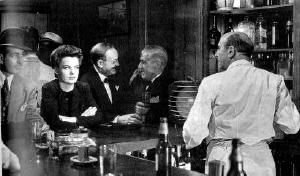
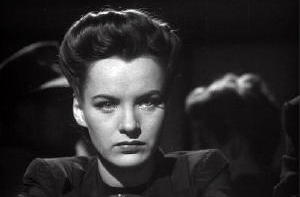
What doesn’t work in this movie, to my mind, are the gaping holes in the plot – there are so many I couldn’t begin to list them all, and I probably shouldn’t anyway – and the fact that the true killer is revealed too soon. I’m not sure if this is true in the book or not, as once again I have not read it in well over 50 years, but a lot of the puzzle is immediately swept away in the movie version. The only question left is how is he to be caught, and of course, he is. (I don’t believe I am giving anything away here.)
In the credits, Franchot Tone’s name is listed first, but since he doesn’t show up until the movie’s well over half over, I’ve switched his name above with Ella Raines, a dark brooding brunette (in this movie, at least). This was only her third film, and she’s the star attraction, all the way. For whatever reason, roles in future flicks seemed to come few and far between, a waste of good talent, as far as I can see.
Alan Curtis is fine enough as the accused killer, an engineer with designs of helping mankind, but in all truthfulness, he seems far too resigned to his fate, nor does he realize how much his secretary is secretly in love with him. A true cipher, but the scenes in the jail between the two of them are beautifully done.
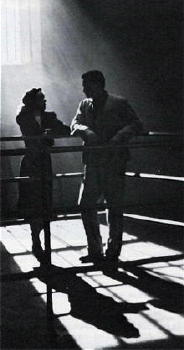
Bosley Crowther’s review in the New York Times seems to sum up all of the negative things I also might tell you about myself. He deserves credit for pointing the atmospheric effects, but how was he to know that later on this would be considered by many to be one of the gems of early film noir?
It is, but I have to warn you, I think he’s still largely right. This movie is a diamond in the rough, one designed for a small (or even large) sense of suspended disbelief. I still think Deadline at Dawn is the better film, but after the showing in Windy City, I seemed to be alone in that belief. I’ll have to watch it again, but do you know what? I’m almost afraid to.
FOOTNOTE: The phantom lady’s name is Miss Terry. How appropriate is that?
Thu 24 Apr 2008
I don’t know if you’ve noticed, but I’ve jammed the last five posts into a span of two days. Ordinarily they’d have been spread out over a week or more, but by the time you read this, I’ll be on my way to Chicago and the Windy City Pulp & Paper Convention.
And I won’t be back until Sunday, with my satchels full of books and magazines and my checkbook empty. Heck, if I plan it right, my checkbook will be empty several hours before the doors to the dealers’ room is open on Friday. It isn’t hard to do at all, especially when you’re traveling in economy mode, as I will.
Some of you I will see there, I am sure. If not, so long until next week.
Wed 23 Apr 2008
SARAH SHANKMAN – I Still Miss My Man But My Aim Is Getting Better.
Pocket, paperback reprint; first printing, July 1997. Hardcover edition: Pocket, April 1996.
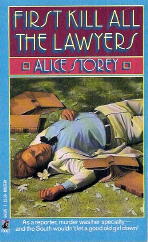
First of all, as you just might possibly have guessed, this is a novel about the Nashville country music business, and I’ll get back to that in a minute. Secondly, it is not one of the books in Sarah Shankman’s series of mystery novels about Samantha Adams, a “cynical crime journalist for the Atlanta Constitution,” says one reviewer of the books. I wish I knew more about them, but I don’t.
For some reason, the series books were begun under another name. See the list below, expanded slightly from Crime Fiction IV, by Allen J. Hubin:
SARAH SHANKMAN. ca.1943- . Pseudonym: Alice Storey.
Impersonal Attractions (n.) St. Martin’s 1985 [San Francisco, CA]
Now Let’s Talk of Graves (n.) Pocket Books 1990 [Samantha Adams; New Orleans, LA]
She Walks in Beauty (n.) Pocket Books 1991 [Samantha Adams; New Jersey]
The King Is Dead (n.) Pocket Books 1992 [Samantha Adams; Mississippi]
He Was Her Man (n.) Pocket Books 1993 [Samantha Adams; Arkansas]
I Still Miss My Man, But My Aim Is Getting Better (n.) Pocket Books 1996 [Nashville, TN]
Digging Up Momma (n.) Pocket Books 1998 [Samantha Adams; Santa Fe, NM]
STOREY, ALICE. Pseudonym of Sarah Shankman.
First Kill All the Lawyers (n.) Pocket Books 1988 [Samantha Adams; Atlanta, GA]
Then Hang All the Liars (n.) Pocket Books 1989 [Samantha Adams; Atlanta, GA]
SARAH SHANKMAN, Editor –
A Confederacy of Crime: New Stories of Southern-Style Mystery. Signet, pb, 2001. [A partial list of authors: Jeffery Deaver, Margaret Maron, Joan Hess, Julie Smith, Sarah Shankman.]
If Sarah Shankman has written any mysteries later than these, I’ve not discovered them, and so, I’m presuming, Samantha Adams’s crime-solving days are also over. Alas, I’ve not read any of them, but I think I shall.
Not that I imagine any of the Adams books will be anything like I Still Miss My Man, a madcap romp that I can compare to anything I’ve ever read before. The nominal star is Shelby Kay Tate, who’s trying to make a name for herself as a singer-songwriter in Nashville. Little does she know that her ex-husband Leroy is bound and determined to get her back, even if he has to kill her to do so.
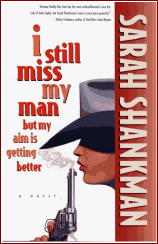
Also little does she know that the policeman who comes to a domestic squabble with herself in the middle of it, Jeff Wayne Capshew, will appoint himself her permanent bodyguard, whether she approves of it or not. (And somewhat secretly to herself, she admits that maybe, just maybe, she might.)
Also little does she know that a former country music great, Gail Powell, in secluded retirement for over 30 years, will see in her the means for a comeback. And least of all does she know, having been born at exactly the same second that Patsy Cline died. That a guardian angel has been watching over her ever since, pushing and prodding events to come together at one time and one place, in this solid ode to honky-tonks and Nashville bars and doughnut shops, and the agony of waiting to be discovered, from a (mostly) female point of view.
Do I miss you
Well I guess I do
Like Joan of Arc might miss a barbecue
I’m tired of your demands
I’ve had more than I can stand
Yeah, I still miss my man
But my aim is getting better
Wed 23 Apr 2008
THE THOMAS CROWN AFFAIR. 1999. Pierce Brosnan, Rene Russo, Denis Leary, Ben Gazzara, Faye Dunaway. Director: John McTiernan.
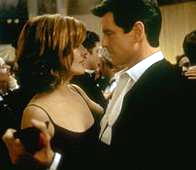
A remake, of course, of the film with the same title that starred Steve McQueen and Faye Dunaway in 1968. To most critics, the remake suffered in comparison, but except for a few plot holes, but major ones, I liked this more recent version just fine. Of course, while my wife Judy says we saw the earlier film when it came out, I don’t remember it at all, for whatever that’s worth. (The link leads to Roger Ebert’s online review. Even when I don’t agree with him, I find myself nodding my head as I read his work, agreeing with every word he says.)
As a matter of fact, I’ve just watched this more recent version twice. Over the period of three evenings I watched it once all the way through, and then, split over the last two nights, I watched it again with the director’s voice-over commentary turned on.

Which I found fascinating. The technical terms are beyond me, what with dolly shots and so on, the former apparently an all-but-forgotten skill, with impressive results, but as he goes along McTiernan also points out little bits and pieces which he realizes that the audience doesn’t really grasp the significance of as they’re watching, including me, but which (perhaps subliminally) begin to add up and start them thinking in the right direction. (Or later on to say, aha, that’s what that was all about.)
Story line: fabulously wealthy financier Thomas Crown (Brosnan) steals in elaborate fashion a valuable painting by Monet from an unnamed Manhattan Museum of Art. Immediately on the case is Catherine Banning, insurance investigator, tough as nails and all woman (Russo). Her instincts are also immediately on target, as she picks Crown for the crime the first day she’s on the job.
She confronts him directly, in violation of all standard police procedure, and thus the game begins. Denis Leary plays the role of Detective Michael McCann, and even though he’s obviously attracted to her, all he can do is stand back and watch the sparks spy.

You have to take the point of view of view, as the script strongly suggests, that stealing works of art is only a prank, a jest, and teasing the cops is all part of the fun. In that sense it’s Brosnan and Russo’s movie all the way, with lots of smooth, colorful photography to illustrate the lives of the rich and the semi-famous. (Detective McCann, in contrast, lives alone, in a dumpy apartment with a TV on the kitchen table. He’s a good sort, though, not jealous – well, maybe just a little, but what can he do?)
At the time the movie played in the theaters, there was a great to-do about Miss Russo’s nude scenes, with a lot made of the fact that she was 45 at the time. Rightfully so. She is also a very good actress, having plenty of opportunity to demonstrate both her repertoire of facial expressions and fully clothed body language.
Faye Dunaway, from the first movie, has an extended cameo role as Crown’s psychiatrist, giving Pierce Brosnan, as the man on the couch, plenty of opportunity to look reflective and puzzled about his own thoughts and behavior. Nonetheless, Miss Russo, who seems to grow softer and more feminine as the movie goes on, shows a bit more range. Even her ever-changing hair-styles are expressive.
Tue 22 Apr 2008
SLOW BURN. 1986. Made for Cable TV (Showtime). Eric Roberts, Beverly D’Angelo, Raymond J. Berry, Emily Longstreth, Johnny Depp, Henry Gibson. Based on the novel Castles Burning, by Arthur Lyons. Screenwriter/director: Matthew Chapman.
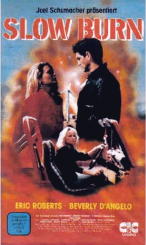
If it hadn’t been for Arthur Lyons’ recent passing, reported here a few weeks ago, I might have never heard of this movie. It’s based on the fifth of eleven private eye novels that Lyon wrote, all of them cases for Jacob Asch, a former reporter who went to jail rather than reveal his sources.
Asch is portrayed by Eric Roberts in this movie. He was 30 at the time, and in the movie he looks younger, a lot younger, or maybe he only acts that way. Of course it may simply be a matter of perspective. In 1986 I was a lot younger, too, but that was then, and this is now.
Nonetheless, I still think of Jacob Asch as being a much older fellow.
A brief explanation is inserted here. This post originally included photo images of both Eric Roberts and Beverly D’Angelo, but unfortunately neither of them came from the movie itself, and I’ve deleted them. At first I thought they were close, but the more I thought about it, the less close and less appropriate they became. I had found a small photo of Johnny Depp that was taken from the film, as was one of Emily Longstreth, both seen below.
But neither of these two are the lead players, so I kept hunting. What I found is even better: a online video of the trailer for the film. Click here. You may have to sit through a short commercial first, but I think it’ll be worth the wait.
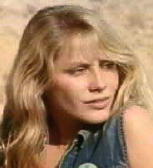
The appearance of Johnny Depp in this film came before he was known for much of anything. He was 23 at the time and playing a high school student of perhaps 18, perhaps he was guilty of pushing it a little the other way. His girl friend, Pam Draper, played by Emily Longstreth, I do not have a year of birth for, but she acts a lot older (and sexier) than a teen-aged girl is supposed to be — she is dating an older man, for example, and later on, she dares Asch to take advantage of her. Wisely, he refuses.
In part that may be because he has already become infatuated with Laine Fleischer (Beverly D’Angelo), the mother of the boy he was hired to locate. Perhaps now is a good time for me to back up. A famous artist named McMurtry (Raymond J. Berry) has asked Asch to find his son, regretting now having abandoned both the boy and his mother (Laine) some 10 years earlier. Laine has now remarried, and as Asch discovers, her son has been killed in an auto accident. Donnie (played by Johnny Depp) is her stepson.

Laine is a slim seductive blue-eyed blonde with many secrets, and it is fascination at first sight, or at least it is in one direction, from Asch’s point of view. But the story really begins when McMurtry learns that his son is dead. He goes crazy, and before the night is over, Donnie has been kidnapped. The play of events that caused these seems obvious to everyone, but obvious never is the case in cases like this.
The movie is has its flaws — it sometimes moves too slowly, and the voice-over narration at times could at best be called trite — but the Palm Springs background and the way the rich people live there, in contrast to the local cops and the local kids, not all of whom have rich parents and some of whom do not have parents who love them enough, provide a setting and theme that thoroughly caught my attention, at least.
There is a scene at the end which is pure noir, and once you’ve seen it, you realize that even though the movie was filmed in color, it had been a noir all the way through. There are other scenes which are even finer. Even though this is only a slightly above average movie (my opinion), some of these scenes I’ll remember for quite a while. (Only one, maybe two at the most are in the trailer.)
And do you know what? The longer I sit here at the computer keyboard, the better I remember liking this movie. A lot.
Tue 22 Apr 2008
As a brief introduction to this piece, I’ll begin by saying that mystery writer John T. McIntyre was the subject of a post you saw here last Saturday, albeit somewhat accidentally so: he was the author of “Blows in the Dark,” the lead story in Complete Detective Novel Magazine for November 1931.
Thanks go first to Mike Grost for the comments he left after that preceding post, during the course of which in part he reviewed Ashton-Kirk: Secret Agent. According to Mike, it starts out as a pure imitation of the Sherlock Holmes stories, then dissipates its early promise into becoming a cliched and routine espionage novel. Not a surprising report, I suppose, given the lack of name recognition that McIntyre has a writer today, but still a disappointing one.
But here is some news. I’ve conferred with Al Hubin, and in the next installment of the online Addenda to the Revised Crime Fiction IV, the books in the following separate entry will be merged with those of John T. McIntyre. (Note the previous misspelling of the author’s name.)
MacINTYRE, JOHN THOMAS. 1871-1951. Pseudonym Kerry O?Neil, q.v.
O?NEIL, KERRY. Pseudonym of John MacIntyre, 1871-1951, q.v.
Mooney Moves Around (n.) Reynal 1939 [Jerry Mooney; Philadelphia, PA] “Private detective murder mystery surrounding the fashion industry.” NOTE: This novel was a SEALED Bonus Mystery. The last chapter of the book, containing the solution to the murder, was tightly sealed in a paper wraparound with printed bonus certificate. The reader would have to break the seal to finish the book. If unbroken, the book could be returned for a full refund; otherwise the purchaser could redeem the coupon for 35 cents.
Death at Dakar (n.) Doubleday 1942 [Senegal] “In which an American newspaperwoman [Patricia Cornell] trumps her opponent?s ace.” Add to setting: Rio de Janeiro, Brazil.
Ninth Floor: Middle City Tower (n.) Farrar, 1943 [Jerry Mooney; Philadelphia, PA] “Jerry Mooney, a cop turned private detective, investigates the disappearance of an expensive ruby and the murder that follows.”
Death Strikes at Heron House (n.) Farrar, 1944 [Jerry Mooney; Philadelphia, PA]
At the moment I don’t know much more about Jerry Mooney. He’s not included in Kevin Burton Smith online directory of private eyes, and what I do know (see above), I’ll pass along to him.
Checking out the pulp fiction written by Kerry O’Neil, I’ve discovered a story written as by him in the October 10,1948, issue of Short Stories, a work called “A Short Shot at Purdy.” Given that John McIntyre’s first entry in CFIV was In the Toils, a criminous play published by Penn in 1898, it certainly makes for a long if not entirely illustrious career.
[UPDATE.] Later the same day. Google is wonderful. I’ve found a long, meaty profile of John McIntyre online here. It’s entitled “Noir Town: The hard life of John McIntyre, the legendary Philly novelist nobody’s heard of,” by Kevin Plunkett (2006). I’d love to reprint it here on the blog, but I’ll remain content to have you follow the link and read it for yourself. Highly recommended!
Here are the last couple of paragraphs:
“At his death, John McIntyre was already fading into obscurity. The intervening decades took care of the rest.
“Today his hard-edged Philadelphia novels are forgotten and ‘only hard core mystery buffs’ are aware of the gutsy writer from Northern Liberties, notes Thomas Whitehead [manager of Temple University’s Special Collections Department]. And hardly a soul peruses the John T. McIntyre Papers. And that’s a shame. Because McIntyre rendered Philadelphia’s darker edges into some of the toughest and finest fiction this city has ever seen. ‘He was the Philadelphia writer who captured the realistic parts of city life: the street life, the politics, the ethnic groups in the city, all the relationships,’ Whitehead says. ‘I think he did it well.'”
Tue 22 Apr 2008
More additions to the ongoing online Addenda to the Revised Crime Fiction IV, by Allen J. Hubin, all from the installment most recently uploaded, Part 26.
There’s not too much in common among these authors, save for one fact: most of these additions came from me, and all but the images in the Maz entry are covers of books in my collection.
And, oh yes, one more thing. The entry for writer Jon Messmann at the end has some unanswered questions within. If you know anything about Mr. Messmann, please add a comment or drop me a line.
ABEL, JOEL S. ca.1939- . Author of one crime novel included in the Revised Crime Fiction IV.
The Jonah Game. Curtis, pb, 1973. Add setting: Bermuda. Leading character: cardplayer Bart Dodge. “It was a dangerous brand of poker … with murder wild…”
ADAM, EVELYN. 1941- . Add as a new author entry. Pseudonym: Dylan Meave, q.v.
BURLESON, CLYDE W. 1934- . After leaving the US Air Force, he was a founding partner and president of an advertising agency in Texas which became one of the largest in the Southwest. Author of 15 books, three of which have been the basis for documentary specials on cable TV. Two of the books are novels included in the Revised Crime Fiction IV; see below.
The Mexican Affair. Carlyle, pb, 1979. Setting: Mexico. [Christian Miles tries to learn how his best friend drowned in a Mexican scuba-diving accident.]
Operation: Evangeline. Carlyle, pb, 1979. Add setting: ship. [A US plan to raise a sunked Soviet sub may blast open the Cold War.]
CRAGGS, JOHN. 1951- . Add as real name of John Mathewson, q.v., plus year of birth.
HACKER, SHYRLE (née PEDLAR). 1910-2000. Born in San Francisco; toured US as a dancer, 1929-34. Teacher & manager of Shyrle Dance Studio, Oakland CA, 1934-45. Award for best mystery novel from Franklin Watts, Inc., 1965, for juvenile mystery, The Mystery of the Swan Ballet. Author of one gothic novel included in the Revised Crime Fiction IV. See below.
Whispers in the Dark. Manor, pb, 1976. Add setting: Nevada. “Enid looked forward to seeing her brother again at Tamarac, her childhood home …”
MATHEWSON, JOHN. Add: pseudonym of John Craggs, 1951- , q.v. Author of one book included in the Revised Crime Fiction IV. See below.
Running Scared. Robert Hale, UK, hc, 1978. A thriller set in the New Forest of southern England: “A poacher is set up to take the blame for a gamekeepers murder but escapes and goes on the run.” [Add setting.]
MAZ. Pseudonym of Alfred Leonardus Mazure, 1914-1974, q.v. Dutch cartoonist, writer and filmmaker. One comic strip creation among others, Dick Bos, was a private detective with a love for martial arts. The books, only 3” x 4” in size, were very popular in the Netherlands. They were translated into several languages, and made into a number of movies. Also the author of three books cited in the Revised Crime Fiction IV, two marginally.
Cash on Destruction. Neville Spearman, UK, hc, 1962. Add setting: Berlin.
-Pigeon Parade. Neville Spearman, UK, hc, 1961.
-Priscilla Darling. Muller, UK, 1963, hc, 95pp. Subtitled: “Being the Adventures of a Young Girl in Search of Happiness,” the tale of a heroine who goes about the world adventuring “in various states of distress and undress.”
MAZURE, ALFRED LEONARDUS. 1914-1974. Pseudonym: Maz, q.v.
MEAVE, DYLAN. Pseudonym of Evelyn Adam, 1941- , q.v. Add as a new author entry.
Fatal Replay. Carlton Press, hc, 1987. “… a novel of mystery and suspense.”
MESSMANN, JON (J.?) 1920-2004. Pseudonyms: Claude Nicole & Claudette Nicole; house pseudonyms: Nick Carter & Paul Richards. Under his own name, the author of 18 crime and suspense novels cited in the Revised Crime Fiction IV, including seven about men’s adventure series hero Jefferson Boone, The Handyman, and six with Ben Martin, aka The Revenger. As a writer of adult westerns, Jon Messman is better known as Jon Sharpe, author of many of the early adventures of The Trailsman books, including the first one. [Note: He may also have been the [Eric] Jon Messmann who wrote comic book stories for Fawcett in the 1940s and early 1950s. Further investigation is underway.]
Phone Call. Signet, pb, 1979. Setting: New York City, NY. Confirm/add: novelization of film: Canadian Film, as Bells, 1982; also released as Murder by Phone (scw: Michael Butler, John Kent Harrison, Dennis Shryack; dir: Michael Anderson). “A device [is developed] whereby those answering a phone can be murdered.”
Sat 19 Apr 2008
Another copy of COMPLETE DETECTIVE NOVEL MAGAZINE from my collection. It’s been a while, so please go back to this previous post for more information about the project this is a part of.
November 1931. Number 41. Total pages: 144, not including covers.
* 8 * John T. McIntyre * Blows in the Dark * novel * illustrated by Leo Morey
* 85 * Ward Andrus Scranton * The Almost Perfect Crime * short story (reporter Jimmie Reed)
* 95 * Jack Martin * The Subway Murders * short story (reporter Hemming Byrd)
* 114 * Ray Torr * The Doctor Crippen Case * true crime article * continued on page 116
* 115 * Samuel Davenport * Final Extra! * short short story
* 117 * James W. Poling * Steps of Death * short story
* 132 * James Moynahan * Rat Poison * short story
Comments: Reporters seem to have been quite the rage, as far as the short fiction in this issue is concerned. The leading character in “Blows in the Dark,” which does not seem to ever have been published anywhere else, is Bob Craige, an adventurer recently returned from Mexico and Central America, only to find waiting for him in New York City a dying man, a beautiful girl, and a Chinese gentleman (I believe I am using the term lightly) named Hong Yo.
As for John T. McIntyre, here is his entry in Crime Fiction IV, by Allen J. Hubin. I’m quite positive that this is the same author as the one who wrote “Blows in the Dark.”
McINTYRE, JOHN (Thomas)
* In the Toils (play) Penn 1898
* -The Ragged Edge (n.) McClure 1902
* In the Dead of Night (n.) Lippincott 1908 [New York City, NY]
* -The Street Singer (n.) Penn 1908
* Ashton-Kirk: Investigator (n.) Penn 1910 [Ashton Kirk; New York City, NY]
* Ashton-Kirk: Secret Agent (n.) Penn 1912 [Ashton Kirk]
* Ashton-Kirk: Special Detective (n.) Penn 1912 [Ashton Kirk; New York City, NY]
* Ashton-Kirk: Criminologist (n.) Penn 1918 [Ashton Kirk; New York City, NY]
* “Slag” (n.) Scribner 1927
* The Museum Murder (n.) Doubleday 1929 [New York City, NY]
* Steps Going Down (n.) Farrar 1936 [Philadelphia, PA]
* -Signing Off (n.) Farrar 1938
One of the books is available online. Follow the link above. About Ashton-Kirk, I’ve found a blogger who has said:
“Until you read the Conan Doyle imitators who were roughly his contemporaries, you can’t understand how reasonable, comparatively, Sherlock Holmes is. Ashton-Kirk is clearly based on Holmes, and yet —
“He’s one of those young, aristocratic cultured gentlemen. And yes, his eyes are piercing, and his fabulous house is in a bad neighborhood, and he’s irritatingly cryptic, but it’s all part of the formula.”
This observation is corroborated by Jess Nevins on his Pulp and Adventure Heroes website, where he says in part:
“Ashton-Kirk, one of the more obvious Holmes homages, was created by John T. McIntyre and appeared in The Popular Magazine and in four collections starting in 1910. Ashton-Kirk is much younger than Holmes, being only in his mid-twenties, the scion of wealth and an ancient line. He has an excellent physique and mind, capable of feats of deduction quite similar to Holmes’ own. Like Holmes, he has a talent for disguise and amateur theatrics, and has a Watson-like assistant.”
[UPDATE.] Regarding the previous entry in this series, the lead novel for which was “The Murders at Hillside,” by Virginia Anne Roth, Bill Pronzini had this to say about the author, after I mentioned to him that I had all of her novels, but I haven’t read one yet:
“I think you’ll enjoy the Rath novels. Good, solid Golden Age plotting, background, and characterization. A suggestion: Start with Death at Dayton’s Folly, her first for Crime Club and one of her best.”
Fri 18 Apr 2008
I’ve been busy recently, but things are starting to look up. After a long break, I’ve finally been able to add some links and images to the online Addenda to the Revised Crime Fiction IV, by Allen J. Hubin. Here are some of the results from Part 25, which I uploaded a short while ago this evening. There’s no connection between the authors so far as I can see. They represent several different genres and sub-genres, but all of them are crime fiction, in one form or another.
And don’t forget: Anything you can add that’s relevant to these authors or their work would be welcome. Corrections, too!
GRESHAM, STEPHEN (LEROY). 1947- . Add pseudonym: J. V. Lewton, q.v. Other pen name: John Newland. Author of many novels of supernatural horror, mystery and suspense, three of which are included in the Revised Crime Fiction IV, two marginally. The author presently lives in Auburn, Alabama, where he teaches creative writing at Auburn University.
-Midnight Boy. Zebra, pb, 1987.
Rockabye Baby. Zebra, pb, 1984. “He rocked them into eternal sleep with a lullaby of death.”
-Runaway. Zebra, pb, 1988.
GREY, EVELYN. Pseudonym of Susan Leslie Liepitz, 1954- , q.v. Add as a new author entry. SC: Serena Miles Camberleigh, in both titles. Both were published as thick Gothic romances at nearly the end of the genre’s period of popularity. (Averaging over 400 pages long, they may have been the longest Gothics ever published.)
Camberleigh. Berkley, pb, 1985. Setting: England, past.
Mayfair. Berkley, pb, 1986. Setting: England, past.
LESLIE, EDWARD. Pseudonym of Leslie Edward Sellicks, 1902- , q.v. Author of three works of crime fiction included in the Revised Crime Fiction IV, one marginally:
The Red Slayer. Herbert Jenkins, UK, hc, 1929.
The Seventh Entanglement. Herbert Jenkins, UK, hc, 1930. Add setting: England.
-White Man’s Prestige. Frederick Warne, UK, hc, 1939.
LEWTON, J. V. Pseudonym of Stephen (Leroy) Gresham, 1947- , q.v. Other pseudonym: John Newland, q.v. Add as a new author entry. Both books below are horror/mystery novels intended for younger readers.
Called to Darkness. Zebra, pb, 1995.
Just Pretend. Zebra, pb, 1994.
LIEPITZ, SUSAN LESLIE. 1954- . Add as a new author entry. Pseudonym: Evelyn Grey, q.v.; other pen names: Ashley Allyn, Susan Leslie. Romance fiction author, some of whose books have crime-related components, including the one below:
Mystic Memories. Jove, pb, 1998. Time travel romance. Setting: Present/past (1833). Leading character: psychic private investigator Cara Edwards, who is hired to trace a young boy who has disappeared on a restored sailing ship.
SELLICKS, LESLIE EDWARD. 1902- . Pseudonym: Edward Leslie, q.v.
Wed 16 Apr 2008
FIRST YOU READ, THEN YOU WRITE
by Francis M. Nevins
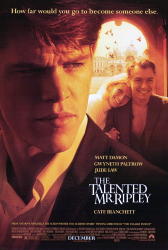
In the second half of March, film noir lost three giants. First and youngest was 54-year-old Anthony Minghella, who died on March 18 of a hemorrhage following surgery. The son of Italian immigrants who owned an ice-cream factory on the Isle of Wight, Minghella came to the attention of mystery lovers when he wrote the scripts for three of the early Inspector Morse telefilms: “The Dead of Jericho,” “Deceived by Flight” and “Driven to Distraction.”
Then he moved to the big screen and made a much larger mark in contemporary noir as director and screenwriter of THE TALENTED MR. RIPLEY (1999). From Colin Dexter to Patricia Highsmith: that, friends, is range. Just before his death he had completed the first two-hour film in what may well become another series of Morse-like longevity, THE NO. 1 LADIES’ DETECTIVE AGENCY, based on the novels of Alexander McCall Smith.
Less than two weeks after Minghella’s death we lost Jules Dassin, the last survivor of film noir’s first generation of directors, who died in Athens on March 31 at age 96. Despite his name, Dassin was born and raised in New York. In the years before the McCarthy-era blacklist forced him to leave Hollywood he directed four noir classics in a row: BRUTE FORCE (1947), THE NAKED CITY (1948), THIEVES’ HIGHWAY (1949), NIGHT AND THE CITY (1950).
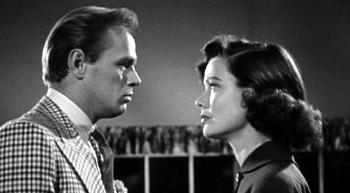
He relocated to Paris in the early Fifties but had to learn French before directing the celebrated noir Euro-heist movie RIFIFI (1954). He was married to Greek actress Melina Mercouri and directed her in NEVER ON SUNDAY (1960) and TOPKAPI (1964).
Between the two directors, Richard Widmark, who had starred in Dassin’s NIGHT AND THE CITY (above) and played lowlifes in a number of other noirs, died at 93. And now in the first week of April we lost Charlton Heston, who will always be remembered as the embodiment of larger-than-life figures from Moses to Michelangelo but also contributed to film noir, making his movie debut as star of THE DARK CITY (1950) and, between THE TEN COMMANDMENTS and BEN-HUR, co-starring with director Orson Welles in the superb TOUCH OF EVIL (1958).
May they all rest in peace. Their film work survives them and will outlive us too.
Thanks to Steven Slutsky, a professor of economics at the University of Florida, I recently learned of a little book that will fascinate all fans of Ellery Queen. The 107-page CHILLERS & THRILLERS was published in 1945 by Street & Smith and exclusively distributed by the Special Services Division of the Army Service Forces.
It appeared as Volume 18 of the “At Ease” series, whose purpose was “to assist the Special Service Officer, the Theatrical Advisor and all other military personnel concerned with the development of the Army recreation program.” These volumes were “not to be resold or made available to civilians.”
Pages 40 through 107 of CHILLERS & THRILLERS are devoted to three episodes of the long-running ELLERY QUEEN radio series: “The Blue Chip” [June 15/17, 1944], “The Foul Tip” [July 13/15, 1944], and “The Glass Ball” [March 23/25, 1944; based on “The Man Who Wanted To Be Murdered,” December 3, 1939].
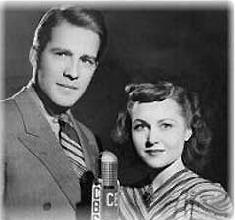
Each episode was adapted for live impromptu staging in GI recreation halls, “with the performers reading from scripts and acting out the action without the use of scenery, costumes or props.” It was expected that these unrehearsed performances would include plenty of boners, which were supposed to “add to rather than detract from the audience’s enjoyment.”
In charge of each staging was a Master of Ceremonies, who “helps the players, prompts them and carries the action when it shows any signs of faltering. He bridges the scene changes and time passages by telling the audience what is happening. He pantomimes such actions as swimming, climbing stairs, walking, running, etc. He simulates sounds when necessary. He may in the course of a sketch become a prop, a corpse, a ferryboat, a radiator or any of a dozen things that are required for the action.”
In lieu of the guest armchair detectives of the radio series, these versions call for “a jury composed of members of the audience. These jurors should be the men in the unit who would be most amusing on the stage, such as the CO, the mess sergeant, the company clerk, and any other ‘characters’ among the men….The jury should be an odd number of men, to avoid a tie vote.”
After the GI playing Ellery announces that he knows who the murderer is, “the jurors are called onstage and polled individually… As they give their choice[s], the MC should question them on the reason for such selection….After the last juror has been polled, the jury is told that it must decide among them which [suspect] is the criminal.
“All discussion of the case takes place in front of the audience. When the MC thinks the discussion has reached the ballot-taking stage, he directs them to vote. After the vote has been taken, the play is resumed and the true solution is unveiled. Prizes are then awarded to the members of the jury who have guessed the correct culprit.”
None of the three EQ scripts has ever been published elsewhere, although “The Foul Tip” is available on audio. CHILLERS & THRILLERS is a must-read volume not only for Queen fans but also for anyone interested in how the men of “The Greatest Generation” were entertained as they fought their war.
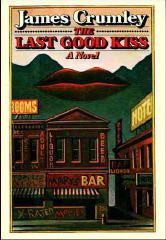
In our Poetry Corner this month is someone who – surprise! – is actually well-known as a poet. Richard Hugo (1923-1982) published his first volume of poetry in 1961 but remained unknown to the mystery-reading world until the appearance of James Crumley’s THE LAST GOOD KISS (1978), one of the finest private-eye novels ever.
Crumley dedicated the book to his friend and fellow Montanan, whom he called the “grand old detective of the heart,” and took its title from Hugo’s “Degrees of Gray in Philipsburg” (“The last good kiss/you had was years ago”).
Hugo made his own pass at the crime genre with DEATH AND THE GOOD LIFE (1981), whose protagonist Al Barnes is a cop, based in western Montana but stopping over in Portland to look into the one ax murder that a recently apprehended serial killer didn’t commit.
Some cop! Overwhelmingly gentle, optimistic about human nature, feeling guilty for the world=s woes, a klutz at police procedure (his idea of a Miranda warning being “You’re under arrest. You know your rights because you’re rich.”), Barnes is de facto a variant of Ross Macdonald’s Lew Archer, a PI investigating a crime of the present with deep psychological roots in the past.
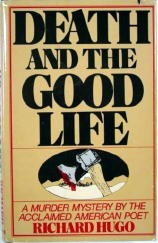
Hugo’s prose is less colorful than Crumley’s and his plotting more complex, but he shares his friend’s genius for creating softly quirky incidental characters, like the tough Homicide captain and the wily criminal-defense lawyer who on the side are both published poets. If he hadn’t died the year after his first novel came out he would surely have written more, with Barnes reconfigured as the Archeresque PI that he is in all but official title in DEATH AND THE GOOD LIFE.
For those who want to check out Hugo’s poetry, perhaps the best starting point is the posthumously published collection MAKING CERTAIN IT GOES ON (1984).
Next Page »



